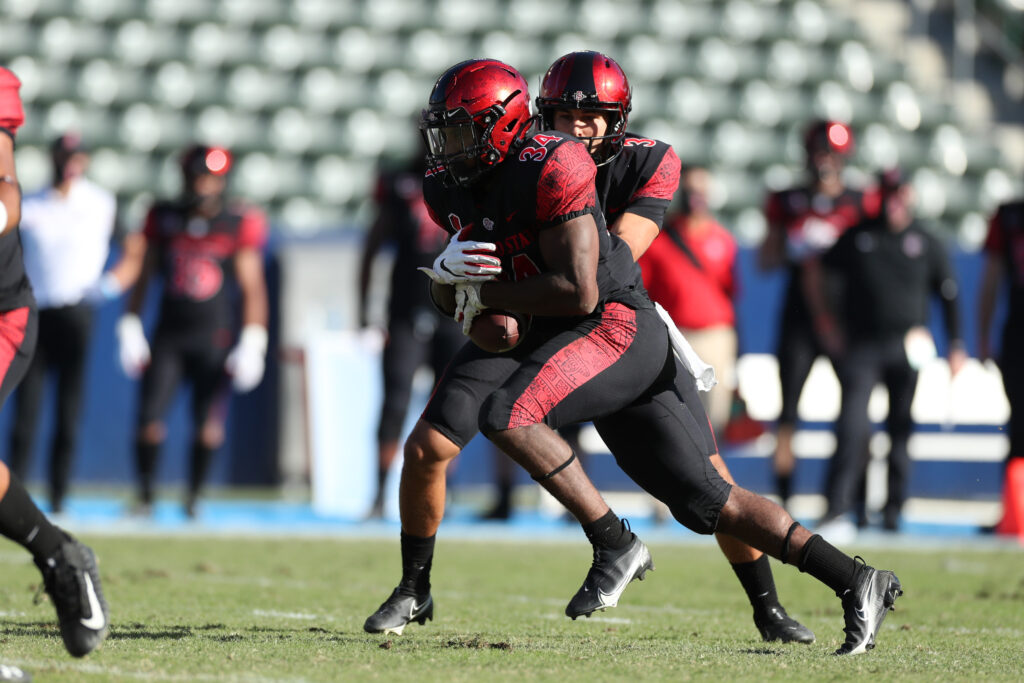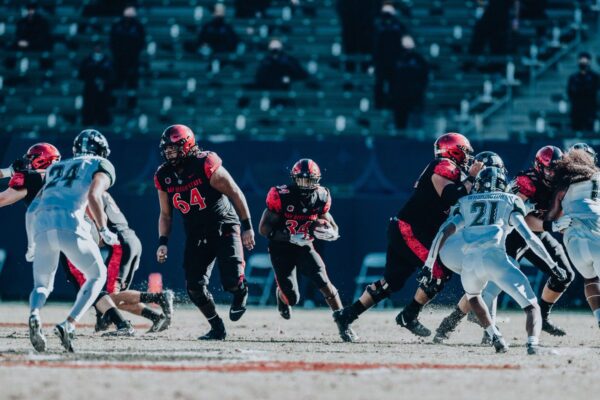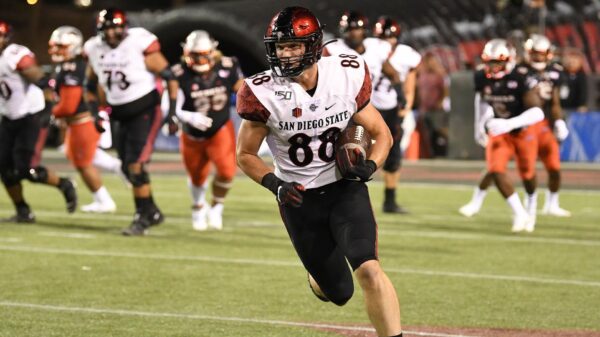SDSU Aztecs football spring camp offensive update

Credit: SDSU Aztecs

On Monday, SDSU offensive coordinator Jeff Hecklinski and senior tight end Daniel Bellinger met with the media. Fresh off another spring practice and a scrimmage this past Friday, they gave insight into several topics related to the offense.
The ultimate focus for the offense is to improve the passing game.
“I don’t think it’s any secret we needed to have consistent quarterback play and needed to be consistent throwing the football,” coach Hecklinski replied when asked what the number one focus was for the offense going into next season. “Other than removing maybe eight or nine throws from the scrimmage, I think we have seen that improvement across the board.”
The Aztecs want to score more points (they averaged 24.6ppg in 2020, ranking 94th out of 128 DI schools), and that will primarily come from turning field goals into touchdowns. Coach Hecklinski does not shy away from emphasizing that they want passing touchdowns in particular. In the eight-game 2020 season, the Aztecs scored six passing touchdowns compared to 14 rushing touchdowns. In almost every practice, the Aztecs run a ten-minute red zone period to work on finishing drives, particularly by passing it to the end zone.
While acknowledging “your QB has to be one of the biggest threats on the field,” coach Hecklinski also spoke at length about how the receiving corps will need to step up and make more plays for the offense, whether that is getting open, making catches down the field or boosting their yards after catch (YAC) average.
He lauded several receivers, including Jesse Mathews and Elijah Kothe, who made “spectacular catches” and gained YAC against the 1st team defense in the scrimmage.
SDSU Offensive Coordinator Jeff Hecklinski on the Wide Receiver group and the goals of the offense as a whole. pic.twitter.com/dr6kPK7gyp
— East Village Times (@EVT_News) April 27, 2021
The extra attention paid to the passing game does not necessarily mean the team is going to abandon its long-tenured ball-control running game. Coach Hecklinski believes that they can be “an explosive offense that averages 42, 45, 49 points per game…but yet still control the game, control the clock and keep our defense on the sideline.” That balance between the run and pass games is something that they are striving to achieve next season.
“I want to hold the ball for 38 minutes and score 42 points.”
Daniel Bellinger will have a big role in the offense.
For the passing offense to reach coach Hecklinski’s desired peak, the tight ends will need to be heavily involved. “The best passing teams that I know of all have a tight end that is one of the biggest threats on the field, and we have one, and it’s my job to put him in that position.” The “one” that coach is referring to is Bellinger, a “really impressive” player who should be getting 12 to 14 targets per game.
Coach Hecklinski described Bellinger as “football smart” who understands all of the offensive concepts allowing the coaches to move him around in different formations and give him one-on-one mismatches against safeties and linebackers.

When asked why Bellinger was not receiving 12 to 14 targets per game last season, coach Hecklinski attributed that to the growth process of the quarterbacks that were playing and the need to simplify the offense to assist in that process. However, he noted that the tight ends caught more passes towards the later part of last season, and he expects that upward trend to continue into the start of next season.
Entering his senior season, Bellinger credits Sava’i Eselu, SDSU tight ends coach, for his overall development in the past year. Coach Eselu, who accepted the coaching position at SDSU last February, has done a great job helping Bellinger with his footwork and YAC ability.
The YAC emphasis has been very evident in spring camp across the receiving groups, but especially in the tight end room, where coach Eselu has utilized small drills to work on catch-and-turn transitions and stiff arms.
This focus paid huge dividends on Friday, with Bellinger delivering the highlight of the scrimmage. With Lucas Johnson under center, Bellinger lined up tight on the left side of the formation. Motioning to his right pre-snap, Bellinger blocked and released outside linebacker Caden McDonald. Johnson took the snap, faked a handoff to Jordan Byrd, who was moving to his left and dumped the ball off to Bellinger for a quick screen. The first defender, Tayler Hawkins, met Bellinger ten yards downfield. With a nifty sidestep, Bellinger juked Hawkins to the ground before delivering a devastating stiff arm to Trenton Thompson. Having disposed of SDSU’s two most experienced defenders by himself, Bellinger outran the rest of the defense and, with Patrick McMorris on his heels, dove into the end zone to complete the 40-yard touchdown. It was a perfect example of how the senior tight end will be utilized this season and how dangerous he has become after the catch.
The biggest transition for Bellinger from high school to college football was adjusting to the speed of the game. He noted in high school. The blocking schemes were relatively simple compared to the schemes in college, which rely heavily on technique and studying defenders’ habits and movements. Bellinger admits that he knew the moment he stepped foot on campus that “if I want to make it to the next level, I not only have to do things in the passing game, but blocking is going to be very important.”
Daniel Bellinger is relishing a leadership role in his senior season.
As Bellinger enters his senior season, he is looking forward to passing down the lessons he learned from his predecessors at Montezuma Mesa. He specifically named Kahale Waring and Parker Houston as two upperclassmen who showed him the way when he was a young player trying to figure out the college football way. He looked up to Waring, who was his locker mate, and spent time showing Bellinger the ropes. In addition, Houston “gave me a lot of good aspects on how to be a leader and how to lead the tight end room.”
The legacy of the Tight End Room was on full display at this evening's press conference. Senior TE Daniel Bellinger talks about past Aztecs greats and what he is imparting to his younger teammates. pic.twitter.com/E0V1SPtK6M
— East Village Times (@EVT_News) April 27, 2021
He also learned about being patient and waiting for his moment from both of them. The tight end position takes time to develop because incoming players are usually recruited strictly for their receiving prowess but have to get stronger and learn the blocking aspect of the position to get on the field. Bellinger understands that now and is focused on imparting that wisdom to the younger tight ends on the team.
While Bellinger is excited to be featured more in the passing game, he is willing to do whatever is best for the team, even if it means more blocking or other tight ends getting more targets. “We’ve been out of the championship for too long, so whatever gets us to the championship, if it means me getting more targets, I am excited for it.” This selfless mentality is exactly what coach Hoke and coach Hecklinski desire from every player that comes through the program.
Bellinger has eyes on a professional football career but also realizes it is important to “get the degree first because the degree is going to get me further in life than just my goals and aspirations for the NFL.”
[wpedon id=”49075″ align=”right”]
This and That
- Coach Hecklinski expects the quarterback competition to continue into at least the summer, praising all three players and noting that he would be very comfortable going into a game right now with any of the three passing it 35 to 40 times out of a total of 90 plays.
- Coach Hecklinski is not overly concerned by the high number of interceptions (7) thrown in Friday’s scrimmage; he feels the quarterbacks have to do a better job with their eyes and staying in their progressions instead of “guessing;” he also believes camp is the time for the quarterbacks to “learn to throw the football under the most intense pressure” and study the film to understand why the interception happened and how it can be prevented in the game.
- Wide receiver transfer Tyrell Shavers is experiencing a learning curve in camp as he is getting used to his 3rd different college system/terminology; coach Hecklinski notes that there are “practices where you can see him settle in and be comfortable and some practices where he is still…unsure of himself…but he has shown strides and started to be consistent.”
- Coach Hecklinski does not believe that the lost time from COVID-19 has stunted the development of the younger players; he feels that with a full spring camp this year, every player should be on an even playing field, and there should be no excuses about lost time from last year.
- Both Coach Hecklinski and Bellinger noted how impressed they have been with young tight ends Jay Rudolph and Aaron Greene during practices and scrimmages.
- Coach Hecklinski praised the offensive line and their improvement throughout the course of spring camp, especially due to the versatility that most of the players possess across multiple positions; he called the current offensive line “as talented as I’ve been around in a long time.”
- Greg Bell was held out of Friday’s scrimmage, and his availability for this coming Friday’s spring game has yet to be determined.
- As with every press conference this spring, Jaylon Armstead was once again mentioned as a player who has performed well.
Avid sports fan and historian of basketball, baseball, football and soccer. UC San Diego and San Diego State alumni living in America’s Finest City. Diverse team following across multiple sports leagues, but Aztecs come first in college athletics.